Many longtime or native Texans picture smalltown living and rural areas when they first hear the words “Denton County.” For most of its history, Denton County has been a set of small communities outside of the Dallas-Fort Worth metroplex. This is no longer the case in many respects, and Denton County is now one of the hottest housing markets in the entire nation. While growth and transformation can benefit a community, it also means that the value of property increases, bringing higher rents and taxes as well. This was clearly seen in 2025, when the Denton Central Appraisal District (DCAD) handed out assessment hikes of 5.9% for homes and 26.4% for commercial properties.
The only way to counter these astounding jumps in value is with property tax appeals and protests. The first round of protests, known as informal appeals, is over, while formal appeals to the appraisal review board (ARB) are starting up. Denton County focuses far more on ARB hearings than informal appeals, so the relatively small savings seen so far should not reflect the overall efficacy of property tax appeals. O’Connor will discuss how efficient protests have been so far and how they can set the table for the next stage in the process.
Informal Appeals Save Homeowners $560 Million in Value
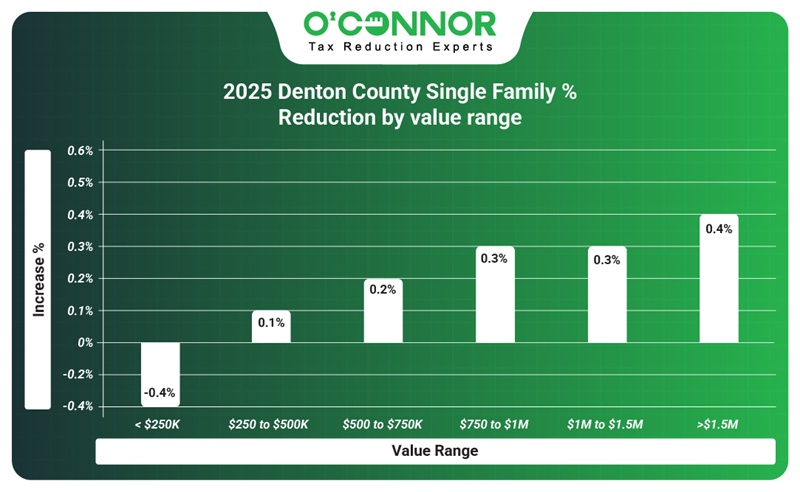
Homeowners were certainly hammered to start 2025, with total taxable value being increased by 5.6%. This drove up the combined total from $146.97 billion in 204 to $155.67 billion in 2025. Appeals were quickly launched, and though they only reduced the total by 0.2%, this still resulted in a value savings of $560.54 million for homeowners. The largest block of homes, those worth between $250,000 and $500,000, saw a reduction of 0.1%, while the No. 2 category of homes worth between 500,000 and $750,000 was reduced by 0.2%. The largest homes also had some of the largest savings with .04%. While these are small percentages, it should be noted that this still cut hundreds of millions of dollars from the tax rolls and does not count many ARB hearings.
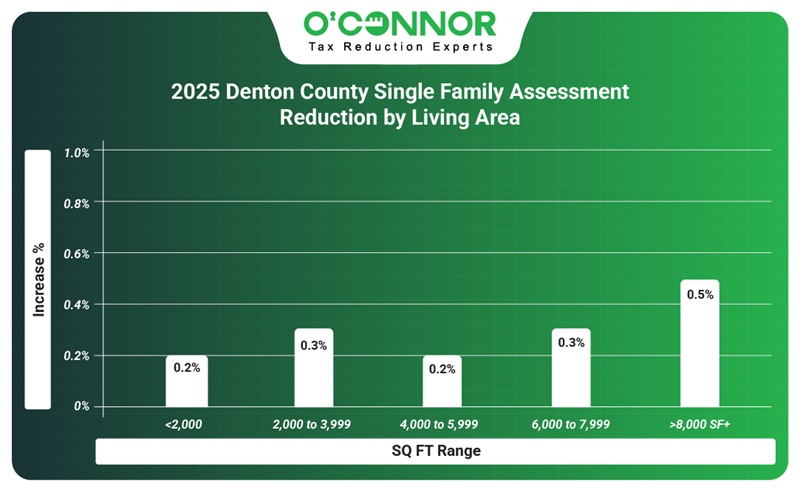
Homes between 2,000 and 3,999 square feet make up the majority of Denton County homes, combining for a value of $95.34 billion. Informal appeals were able to reduce that number by .03%, which translated into a value savings of $240.90 million. Homes smaller than that represented $34.20 billion in value and saw a savings of 0.2%. While small in percentage, these two categories represented a good chunk of savings coming back to the average homeowner. As above, the largest homes on the market saw the biggest percentage victory, with those homes over 8,000 square feet getting a value cut of .05%.
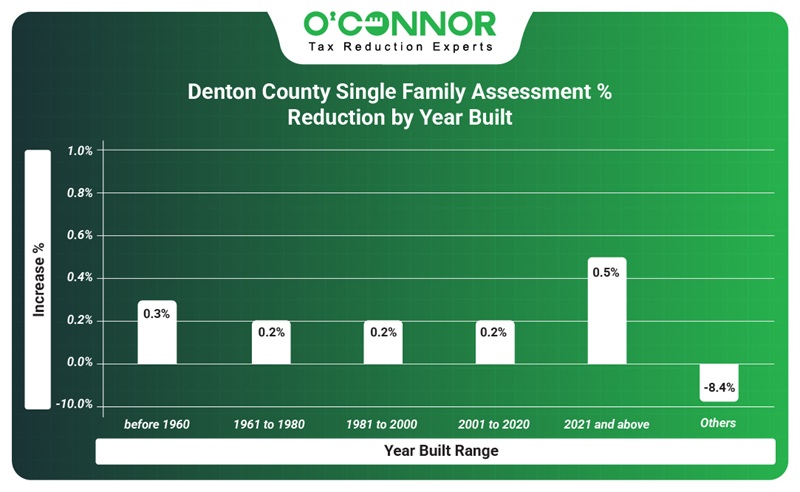
Given its status as a boom area, it comes as no surprise that Denton County’s residential value was mostly built between 2001 and 2020. 52% of all value was created in this timeframe, while an additional 15% was produced thanks to new construction. These categories saved .02% and .05% respectively, a total of $285.84 million. Homes constructed between 1981 and 2000 were responsible for 25% of all value, and managed protest savings of 0.2%. No matter the age of a home, all benefited from protests, and will see even better results from ARB hearings.
Denton Commercial Properties Reduced by $497.88 Million
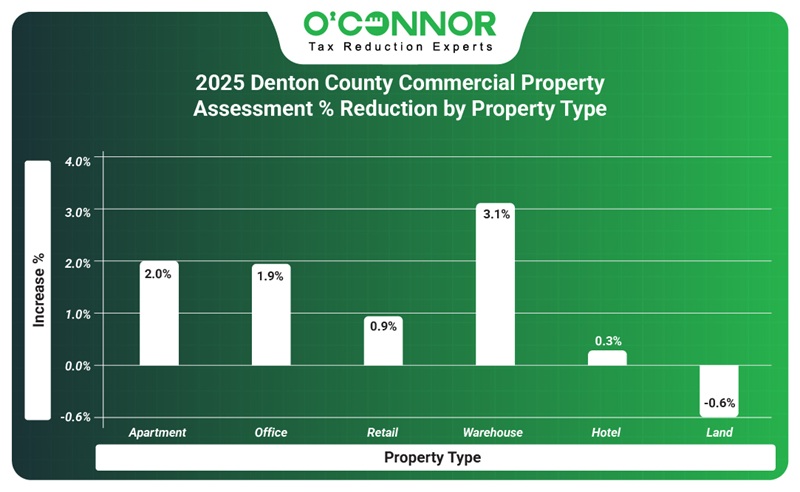
The headline for 2025 was the enormous hike in commercial property values, a jump of 26.4% or $12.49 billion. No commercial subtype got an increase below 20%, while most surged by over 30%. Apartments are the largest block of value in Denton County as far as commercial properties go, and they were able to snatch back a little value with a decrease of 2% thanks to protests. Retail and offices, the No. 2 and No.3 categories, saved 0.9% and 1.9% respectively. Warehouses saw a massive spike of 34% to start 2025 but managed a solid reduction of 3.1%.
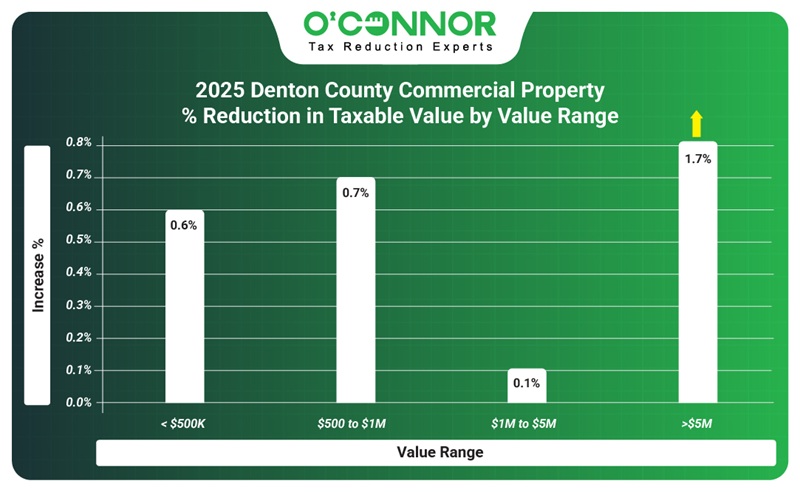
Across America, when the worth of all commercial property is calculated, it is usually the largest businesses that account for most value. This is certainly true in Denton County, as commercial properties worth over $5 million accounted for $27.25 billion of the $38.84 billion total. These big businesses managed to get a reduction of 1.7%, the largest percentage and value cut. However, the No. 2 category of businesses worth between $1 million and $5 million only received a reduction of 0.1%. Small and medium commercial properties managed savings of 0.6% and 0.7% respectively. Commercial properties are laser-focused on ARB hearings and savings from formal appeals should surpass these savings by several factors.
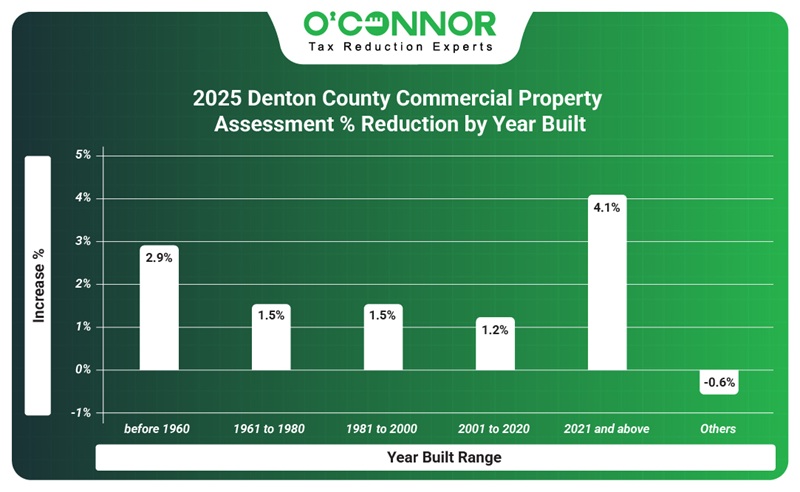
Commercial properties followed the pattern set by residential ones almost to the letter. The majority of businesses were constructed in the boom period between 2001 and 2020, with 36% of all value having its origin in that timeframe. New construction likewise accounted for 15% of the total. Recent construction saw a savings of 1.2%, while new construction got a solid 4.1% back thanks to protests. Commercial properties built between 1981 and 2000 were another large block and got a decrease of 1.5%. All of these reductions totaled a savings of $497.88 million, and this is just the informal appeals.
Denton County Apartments Receive Key Reductions
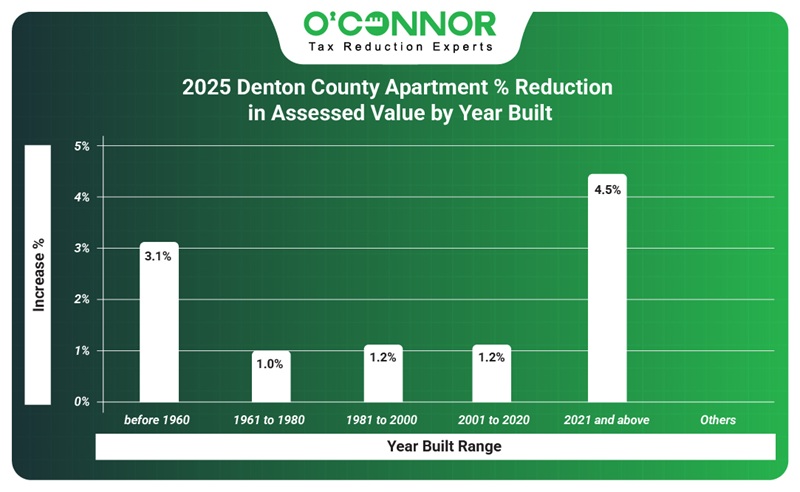
As the No. 1 source of commercial value in Denton County, apartment costs are important for both owners and renters. We have already seen how valuable homes have become, and this can be transferred to apartments as well. The value of apartments increased by 20% in 2025, something that desperately needed protesting. Informal appeals have already knocked down this figure by 2%, or a total of $394.48 million. Apartments share the same boom construction focus as other properties, with 44% being built between 2001 and 2020, while 23% of value comes from new construction. New construction saved 4.5% in value, while those built from 2001 to 2020 saved 1.2%.
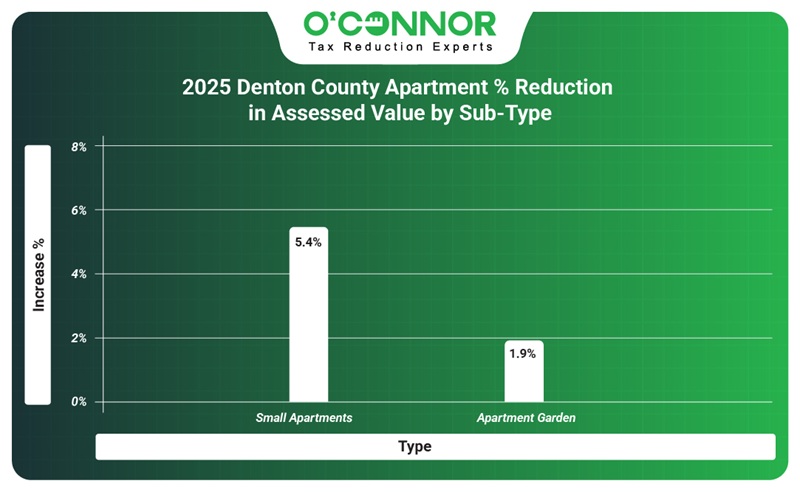
DCAD only classifies apartments as small and garden apartments, making understanding the breakdown of value difficult. Garden apartments accounted for $18.52 billion in value, opposed to only $729.84 million from small apartments. Garden apartments got a reduction of $352.73 million thanks to a decrease of 1.9%. Small apartments did get a respectable return of 5.4%.
Denton County Offices Reduced by 1.9%
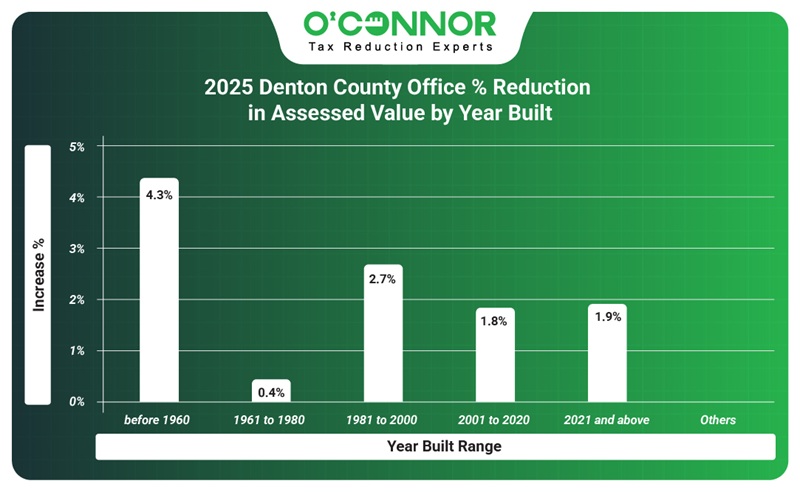
Office values have swung all over the place in the past decade, mostly thanks to the pandemic and shifting work culture. Offices rebounded by 29.4% in 2025, showing that office space is still in demand. To counter this new spike, initial property tax appeals were able to slash value by 1.9%, a savings of $60.78 million. Like everything else in Denton County, most offices were built between 2001 and 2020, with an estimated 58% of all value being created in this time span. New construction is already 10% of the total and rising fast. These categories saw reductions of 1.8% and 1.9% respectively.
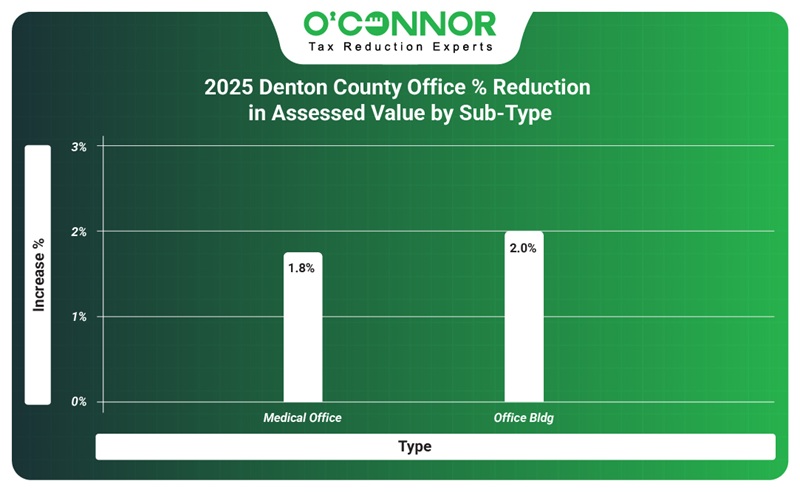
Like apartments, DCAD skimps on details when it comes to offices, only breaking them down between generic buildings and medical offices. Office buildings accounted for a value of $2.31 billion after being reduced by 2%, while medical offices were valued at $794.14 million after a cut of 1.8%.
Denton Strip Centers Save Big
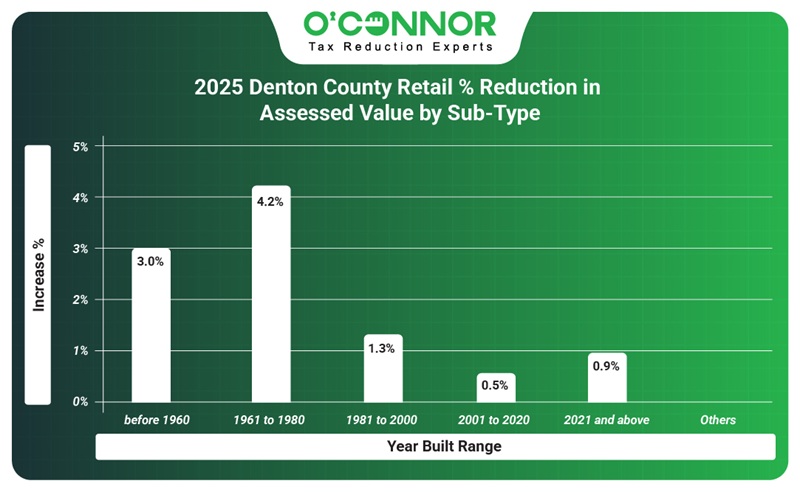
Retail properties totaled $3.98 billion in 2025, making them one of the top commercial properties. Protests were able to decrease this by .09% in the informal phase. Like all other properties, most retail value was built between 2001 and 2020, accounting for 60% of the total. This major block was protested down by 0.5%, which barely moved the dial. New construction is quickly taking over, and managed to account for 11% of the total, even after being reduced by .09%. As is Denton County tradition, retail spaces built between 1981 and 2020 were the No. 2 source of retail value. This category of property was cut by 1.3%.
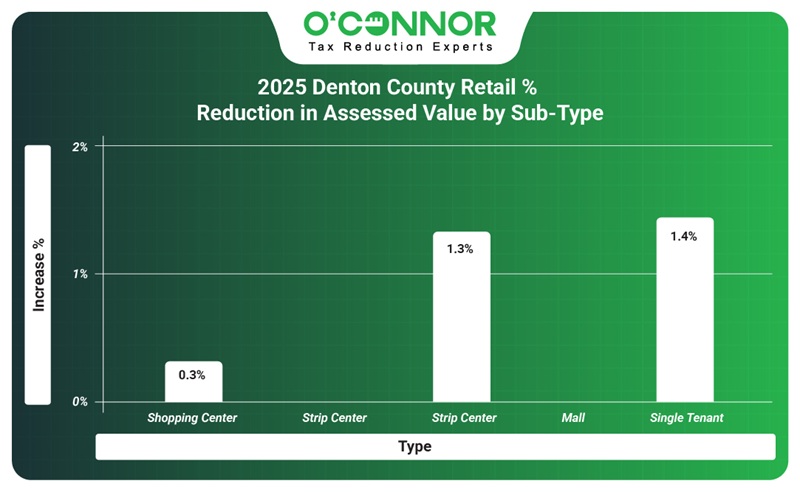
Retail properties are thankfully broken down better by DCAD. Through this, we can see that strip centers are the most valuable retail space in Denton County, even after they got a reduction of 1.3%. The second-largest source of value was neighborhood shopping centers, which saved a paltry 0.3%. Single-tenant retail spaces did well with a return of 1.4%. Shopping centers and malls received very small cuts, but they also accounted for relatively little value across the county.
Warehouses Save the Most
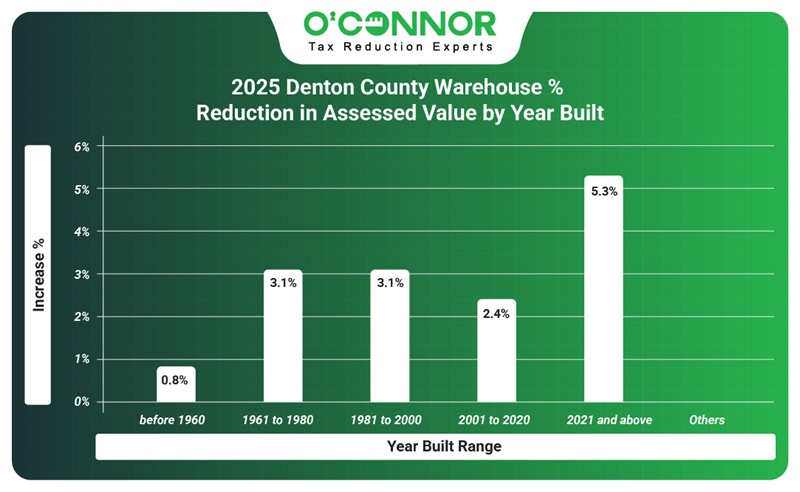
Warehouses saw a massive spike of 34.9% in 2025, the largest percentage gain of any single property type. This brought the value of all warehouses to around $2.07 billion. A small dent was made in this hike thanks to protests getting back 3.1%, or $65.15 million. Warehouses did not buck the trend when it came to construction time, with the biggest chunk of value being built between 2001 and 2020. One contributor to the rise in warehouse value was a spate of new construction, which is now responsible for 18% of the total value. While new construction’s total value grew by 38.1% in 2025, it managed to be protested down by 5.3%.
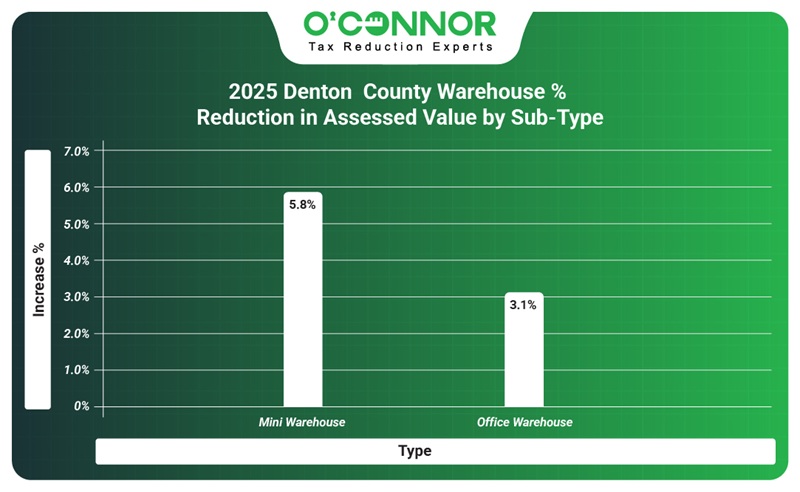
Warehouses are only given two subtypes, which is not too helpful in understanding how value was calculated. Generic warehouses, to no surprise, got the majority of value at $2.01 billion. Mini warehouses, oddly enough, got a tiny slice of the pie at $28.80 million. Generic warehouses were reduced by 3.1%, while mini warehouses nabbed a cut of 5.8%.
Denton County – an Incomplete Story
Considering the mammoth increases that hit Denton County in 2025, the responding protest cuts seem like a slap on the wrist. On the surface, this certainly rings true, even with hundreds of millions of dollars in value coming back. But, as stated above, we have yet to hear from many ARB hearings. From historical data, we can see that Denton County often sees formal reductions that are triple, quadruple, or even higher than those from informal appeals. This is true for both residential and commercial properties, though businesses can see massive savings.
ARB hearings can take months to shake out, so the true impact of property tax appeals will not be felt for months. This could even take years to work out, as lawsuits like binding arbitration and judicial appeals can take a long time to be heard by the courts. Therefore, the savings in this article can be seen as a prologue, not the end of the story. This is becoming the norm for high-dollar counties like Denton, putting it in the rarified air of places like Travis County.
This should reinforce the need for property tax appeals for anyone in Denton County. We at O’Connor are one of the largest property tax specialists in America and are based in Texas. We understand how the Texas system works and have insight into how DCAD can best be countered. If you have an ARB hearing coming up or are considering a lawsuit, O’Connor can help. We also protest taxes for you annually, meaning that we can start saving you money next year if you missed your 2025 protest opportunity. This is a marathon, not a sprint, and it is never too late to get started.

